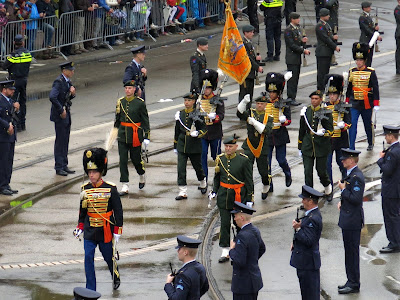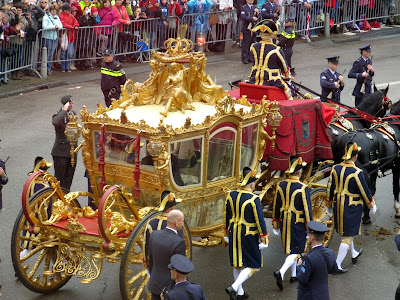After a very wet month at last a sunny day at the beginning of autumn. Time for some fresh air before singing Evensong. Living in a very urban and built up area, in the West of
Holland, what is generally called “The Randstad”, it is amazing what I saw on a
walk of just some two and a half hours. Two thirds of the walk went through
parks and small recreational woods. The walk circled two moated castles, the
first one, Endegeest,
now the head office of a mental hospital, the second, Poelgeest, a conference
centre and hotel. They both have a rich history. Endegeest had several famous
inhabitants, one of them Descartes.
It was built between 1647 and 1651, although Castle Endegeest was already
mentioned in 1307.
The French Lily in the courtyard of Endegeest
A close-up of the statue of Descartes who lived in Endegeest for some time during his years in the Netherlands
An unusual perspective of the castle
Oud-Poelgeest, front and back
There was another mansion in large grounds, grounds which
are now more or less neglected and nature can run its course without
interference of humans. It is Rhijngeest,
presently used as a town hall and at one time also part of the mental hospital.
Between being transformed from hospital into Town Hall, it formed the
background for a television series called “We Alexander”, about prince
Alexander, who lived from 1851-1884.
I walked from Rhijngeest
through a wooded area to Endegeest,
which has beautiful grounds. Apart from woods and landscaped gardens all around
the different pavilions, there are also kitchen gardens which are tended by the
patients. The produce is for sale in a wooden building in the grounds. They are
well known for their honey, and at this time of year pumpkins are a favourite.
Just outside that area a footpath skirts a meadow with some
lazy and contented cows, guarding a stork’s nest on a pole, and ends near
playgrounds for kids and extensive allotments, well tended by people who
apparently love flowers and vegetables, pottering in the warm autumn sun.
Sunflowers and pale lilac Michaelmas daisies were opening their golden hearts
to the sun.
Nasturtiums running wild in one of the allotments
A lovely walk on a very narrow dike, well hidden from an
adjacent housing estate and flanked by two ditches took me to a yet another park.
This was once the garden of Nieuweroord, a lovely mansion
which was broken down in the sixties and replaced by an ugly high rise
apartment building, to be used as a home for training nurses in the nearby
academic hospital. Later it became a centre for asylum seekers and refugees. Now
it is just an eyesore and there are rumours that it will be broken down again. The
landscaped gardens are still intact and serve as a public park. Jan Wolkers, a
famous Dutch novelist and sculptor who was born and raised in this town,
mentions the park in his book “Return to Oegstgeest”. The attractive small
lakes and the little stream still exist, and in spring unusual plants and bulbs
give testimony to a different past. It is such a pity the lovely old mansion
was reduced to rubble, something which probably wouldn’t happen today. But in
the sixties that is what happened everywhere. A woman once peering intently at
the little stream told me she had seen a kingfisher and hoped to see it again. I
have never been so lucky.
A young member of the audience fascinated by the intsruments
The band stand seen from the small lake, and the fountain in the lake
After crossing a main road, and a side street I entered
another park, with yet again a stork’s nest on a pole, plus a deer park and a
lovely pond with a fountain. The storks were probably already on their way to
Africa by now, but the nest was used this spring and summer and one young stork
was raised here. In a bandstand an amateur brass band was playing.
A farmhouse in the park
I walked on, past an old farmhouse, now a nature information
centre, and crossed another road to enter the grounds of the next castle, Poelgeest. In spring the grounds are covered with snowdrops,
followed by a carpet of wild anemones. In autumn the beech trees are a
beautiful coppery yellow.
It is not just the grass which is always greener on the other side... At least this sheep thinks so
I rounded the circular walk passing several sports fields, a
low rise old people’s housing estate with a big lawn in front and magnificent
trees, along streets with very attractive homes dating back to the thirties,
and along another small wood, towards home. Two castles, two storks’ nests,
cows, sheep, deer, woods and parkland, all within this busy urban area, on just
a leisurely walk on a quiet Sunday morning.
The gates and driveway of Oud-Poelgeest
































